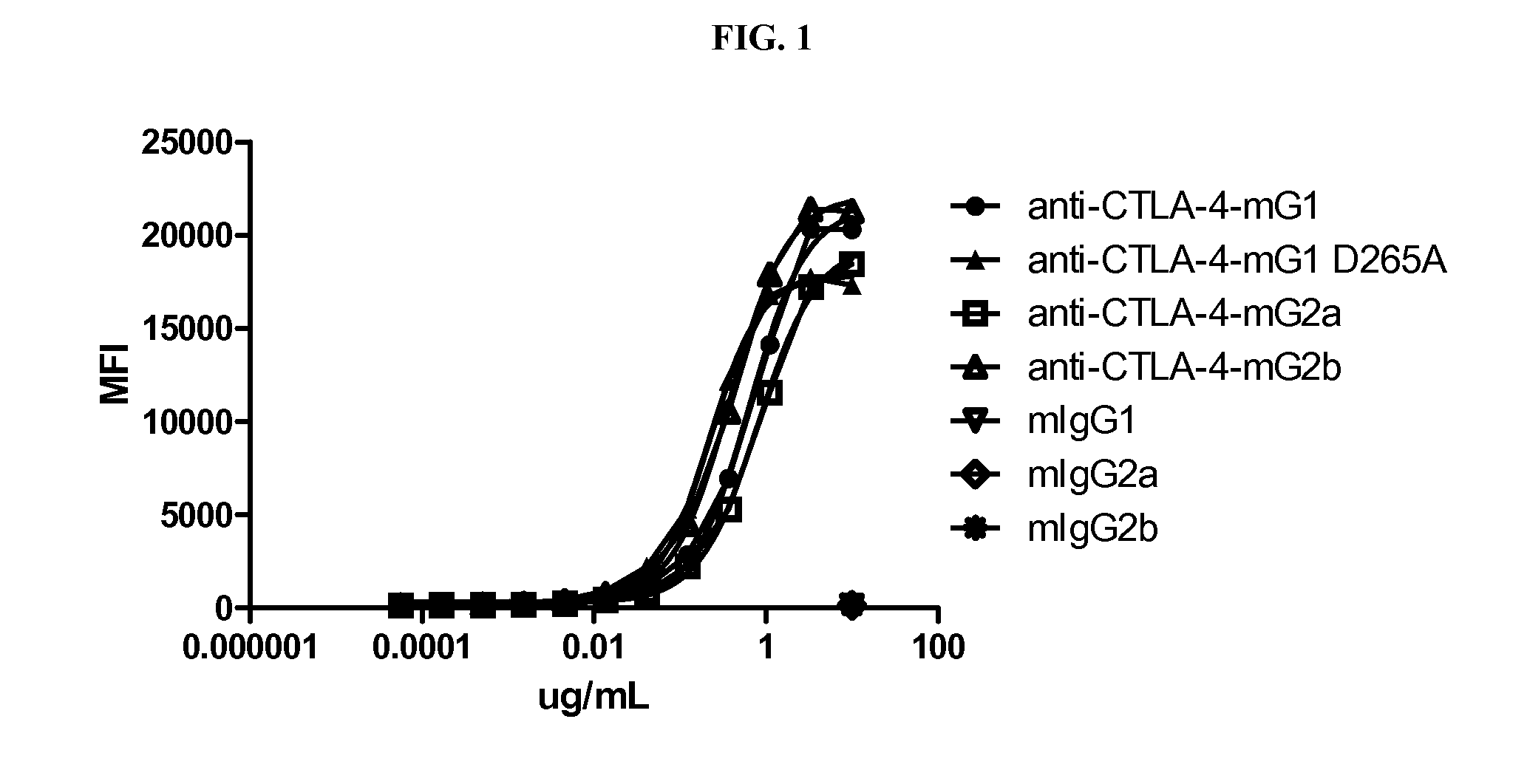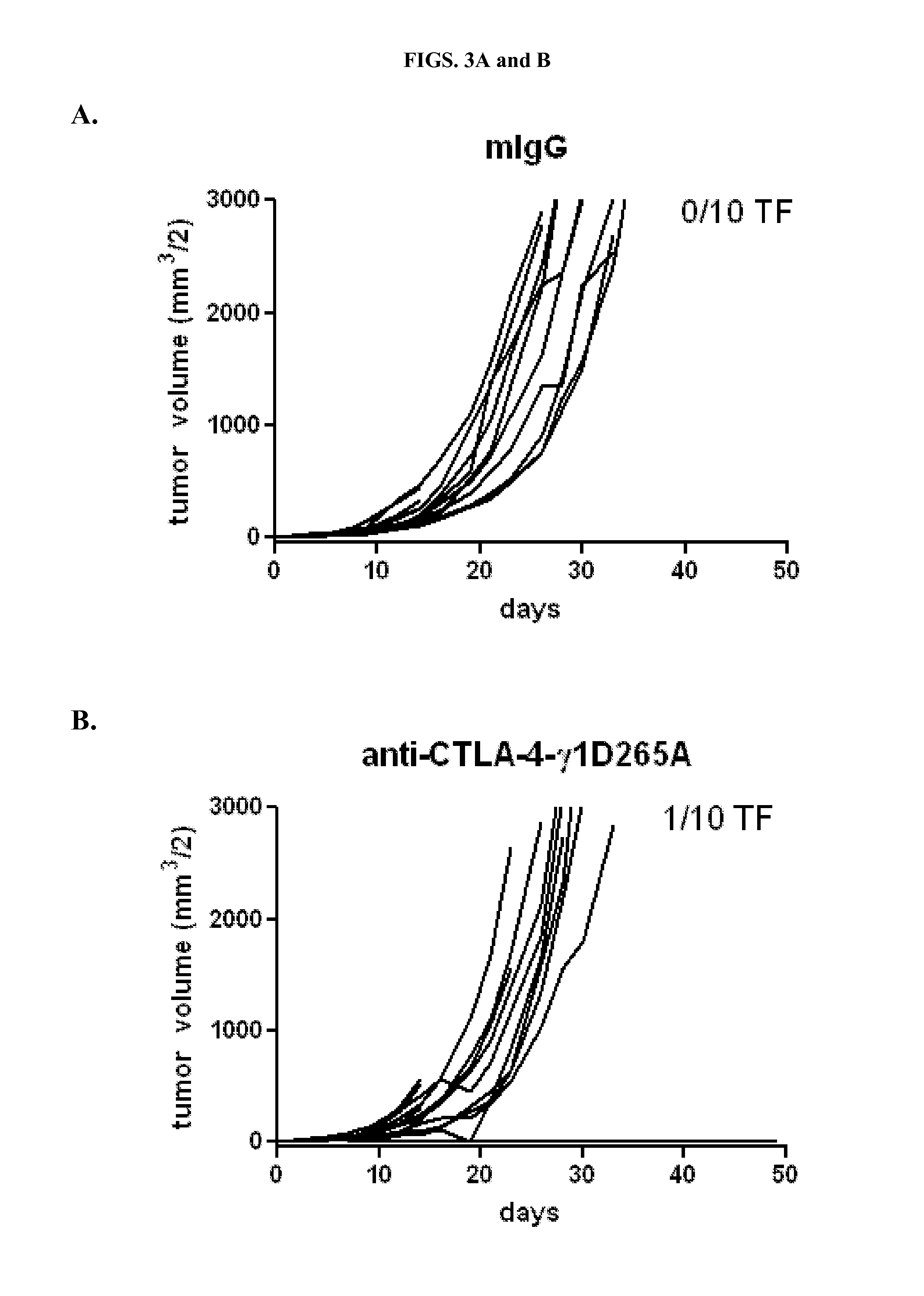Enhancing Anti-cancer activity of immunomodulatory fc fusion proteins
a technology of immunomodulatory fusion proteins and anti-cancer activity, which is applied in the direction of antibody medical ingredients, drug compositions, peptide sources, etc., to achieve the effects of enhancing, optimizing or maximizing the anti-tumor efficacy of an fc fusion protein, potentiating an endogenous immune response, and enhancing binding
- Summary
- Abstract
- Description
- Claims
- Application Information
AI Technical Summary
Benefits of technology
Problems solved by technology
Method used
Image
Examples
example 1
Generation of Different Anti-mCTLA-4 Antibody Isotypes
[0170]To determine the relative potency of different isotypes of anti-CTLA-4 in antitumor activity, four isotypic variants of the mouse anti-mouse CTLA-4 antibody, 9D9, were generated and purified from CHO transfectants or the parental hybridoma. These anti-CTLA-4 variants included the IgG1 isotype containing a D265A mutation (IgG1-D265A), which is a non-FcγR-binding mutant (Clynes et al., 2000), IgG1, IgG2b (original isotype of 9D9, derived from a hybridoma), and IgG2a. The 9D9 hybridoma (kindly supplied by J. Allison, University of Texas, MD Anderson, Houston, Tex.) is a mouse anti-mouse CTLA-4 antibody derived by immunization of human CTLA-4 transgenic mice with mouse CTLA-4 (Peggs et al., 2009). 9D9 blocks the binding of murine CTLA-4-Ig to B7-1-positive cells (data not shown).
[0171]To generate 9D9 isotypes, total RNA was prepared from 9D9 hybridoma cells using the RNeasy Mini Kit (Qiagen, Valencia, Calif., USA). cDNA was pre...
example 2
Anti-Tumor Activity of Variant Anti-CTLA-4 Isotypes in Murine CT26 Colon Adenocarcinoma Tumor Model
[0182]Many different antibodies have been used to demonstrate activity of anti-CTLA-4 antibodies, including hamster anti-CTLA-4 antibodies, 9H10 (Krummel and Allison, 1995) and 4F10 (Walunas et al., 1994), and the mouse anti-mouse CTLA-4 antibody, 9D9 (Peggs et al., 2009). In order to determine the relative potency of different isotypes of anti-CTLA-4 in anti-tumor activity, three of the four isotypic variants of anti-CTLA-4 antibody 9D9 generated (anti-CTLA-4-γ1D265A, anti-CTLA-4-γ2b, and anti-CTLA-4-γ2a, which bind equally well to CTLA-4+ cells as described in Example 1) were tested together with a mouse IgG1 isotype control for anti-tumor activity in a syngeneic CT26 colon adenocarcinoma model. The control antibody used for the studies is a recombinant human anti-diphtheria toxin antibody with a mouse IgG1 isotype.
[0183]Ten BALB / c mice were subcutaneously injected with 1×106 CT26 tu...
example 3
Effects of Anti-CTLA-4 Isotypes on CT26 Intratumoral T Cell Subsets and Peripheral T Cell Populations
[0184]Lymphocyte Staining Analysis
[0185]In order to measure the effect of different anti-CTLA-4 isotypes on T cell populations, T cells isolated from mice treated with the different antibodies were stained for the presence of CD8, CD4, CD45 and Foxp3 markers. All mice were sacrificed and tumor and draining lymph node were harvested for analysis on Day 15 after tumor implantation. Single cell suspensions were prepared by dissociating tumor and lymph node with the back of a syringe in a 24-well plate. Cell suspensions were passed through 70 μm filters, pelleted, resuspended, and counted. Cells were then plated in 96-well plates with 1×106 cells per well for staining Cells were treated with 24G.2 (BioXcell), which blocks Fc binding to FcγRIIB and FcγRIII, and subsequently stained with antibodies against CD8 (clone 53-6.7; Biolegend), CD4 (clone GK1.5; Biolegend), and CD45 (clone 30-F11;...
PUM
| Property | Measurement | Unit |
|---|---|---|
| Immunogenicity | aaaaa | aaaaa |
| Level | aaaaa | aaaaa |
| Inhibition | aaaaa | aaaaa |
Abstract
Description
Claims
Application Information
 Login to View More
Login to View More - R&D
- Intellectual Property
- Life Sciences
- Materials
- Tech Scout
- Unparalleled Data Quality
- Higher Quality Content
- 60% Fewer Hallucinations
Browse by: Latest US Patents, China's latest patents, Technical Efficacy Thesaurus, Application Domain, Technology Topic, Popular Technical Reports.
© 2025 PatSnap. All rights reserved.Legal|Privacy policy|Modern Slavery Act Transparency Statement|Sitemap|About US| Contact US: help@patsnap.com



